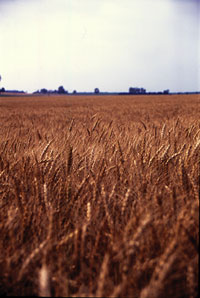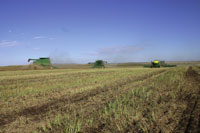
Features
Agronomy
Cereals
Winter wheat potential looks good for the fall
With market outlooks looking strong, focus on good agronomics to maximize profitability.
October 18, 2008 By Top Crop Manager
With market outlooks looking strong, focus on good agronomics to maximize profitability.
A rising tide lifts all boats and so it goes with winter wheat in this current global commodity shortage. Winter wheat prices have gone up in step with other commodities, and may have benefitted even more, given that high protein wheat is trading at a price that has buyers looking at all milling wheat.
 |
| One advantage of winter wheat is that it often does not require a wild oats herbicide if a good plant stand is established and survives the winter. |
 |
| A focus on stand establishment will improve winter wheat production. Photo courtesy of Rick Taillieu, Reduced Tillage Linkages |
“Winter wheat (CWRW Select) has typically traded around the price of CPS wheat, but it seems to be moving higher than CPS now,” says Dale Soetaert, Ducks Unlimited agronomist from Edmonton, Alberta. “I think we’re seeing a better marketing job in the higher protein winter wheat varieties, and so we are starting to see a higher price for high protein winter wheat, compared to CPS.”
While #1 CWRW Select 11.5 percent protein prices are still about $0.70 per bushel lower than #1 CWRS 13.5 percent protein, they were not far off at $9.82 per bushel compared to $10.56 per bushel in the March Pool Return Outlook. With higher winter wheat yields, growers often have the ability to exceed CWRS returns. In most years, a well-managed winter wheat crop has the potential to yield up to 20 percent more than spring wheat, and if a drought hits spring wheat in July, winter wheat yields can be even higher.
To be successful with winter wheat, though, growers need to target good agronomics, including variety selection, seeding date, seeding rate and depth, a good fertility program and weed control. Good stand establishment in the fall sets the stage for a successful winter wheat crop.
The basic guidelines to stand establishment include seeding early, seeding shallow and seeding into standing stubble free of weeds. While seeding dates vary according to soil zone, generally, earlier seeding dates are required for areas with colder fall soil temperatures. In the north, growers should aim for seeding between the 15th and 20th of August. In central areas, ideal seeding is between the 25th of August and September 5th.
In the south, the ideal seeding date is the first two weeks of September, but seeding can be postponed until later in September if harvesting is delayed.
For seeding rates, target plant populations of 30 plants per square foot in the fall to achieve a spring plant stand of 18 to 23 plants per square foot. Always use 1000 kernel weight calculations to determine seeding rates in plant per square foot.
Seeding shallow into standing stubble also helps improve fall germination, growth and overwinter survival. Even under dry conditions, seeding less than one inch deep is recommended to allow the plants to emerge and grow to the three to four leaf stage prior to freeze-up. Standing stubble also helps collect snow and insulate the crown tissue from cold winter temperatures. Canola stubble is often the first choice for many growers seeding winter wheat.
New weed control research
One advantage of winter wheat compared to spring cereals is that it often does not require a wild oats herbicide if a good plant stand is established and survives the winter. That can easily save $12 per acre or more. Winter annuals, weeds like stinkweed and flixweed though, can provide significant competition. These weeds germinate and establish in the fall and then resume growth in the spring, often out-competing winter wheat.
Most growers control winter annuals in the fall with 2,4-D or MCPA application. This application is relatively inexpensive and can be effective on a single flush of weeds. However, a fall phoenoxy herbicide application does not control some problem weeds that are starting to creep into Canada from south of the border.
Cheatgrass, Japanese brome and downy brome are causing problems for growers south and north of the 49th Parallel. These weeds emerge in the fall or very early spring, and often reach reproductive stages before spring crops are sprayed with post-emergence herbicides.
Kevin Staska, technical services manager with Arysta LifeScience in Minnesota, says research in the US has found that a pre-seed or pre-emergence burndown tank-mix of glyphosate and flucarbazone (Everest) provides good activity on cheatgrass and Japanese brome and suppression of downy brome. The use rate of flucarbazone is 8.5 grams per acre (0.3 ounce per acre) in a tank-mix with the normal pre-seed burndown rate of glyphosate. In the spring, if brome species continue to germinate or compete with a thin winter wheat stand, an 8.5 gram per acre (0.3 ounce per acre) rate of Everest can be applied to tillering winter wheat to clean up cheat, Japanese brome and suppress downy brome. The burndown flucarbazone product was registered in the US in 2007 and was named Pre-Pare.
“What we are finding with Pre-Pare, is that not only does it control a lot of the brome species, but it also weakens the surviving brome plants. So the weeds go into the winter in a weakened state and many of those don’t survive the winter,” says Staska. “Because both Pre-Pare and Everest control flush after flush, the sequential application of Everest in the spring showed very good control of true cheat and Japanese brome in our research trials.”
Brain Schilling, technical services manager with Arysta LifeScience in Edmonton, Alberta, says research trials are planned in Canada in the future to see if there is an agronomic benefit for the flucarbazone/glyphoste pre-seed burndown in winter wheat. He says that on the Canadian prairies, growers might also expect to see improved weed control with the pre-seed burndown tank-mix. “It will be interesting to see if the pre-seed burndown has other benefits that we haven’t seen in the US,” says Schilling.